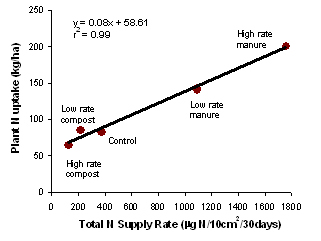PRS Technology
Relationship to plant uptake

Relationship between cumulative N supply rates measured using PRS™-probes during the first 30 days after planting and potato plant N uptake at time of top kill.
Source: Dr. Derek Lynch, OACC, Truro, NS., and Dr. Bernie Zebarth, AAFC, Fredericton, NB.
The PRS® Probe is an effective surrogate for bio-mimicking nutrient absorption by plant roots. All of the principal edaphic factors affecting nutrient supply to plant roots also affect nutrient supply to the PRS® Probe. It is not surprising then that the PRS® Probe nutrient supply rates are highly correlated with plant nutrient uptake. Many studies have looked directly at the ability of the PRS® Probe to correlate directly with plant uptake by analyzing plant tissues for nutrient concentrations with great success (see examples here).
Correlations between PRS® Probe supply rates and plant uptake:
|
Ionic Species |
PRS® Probe type |
R2 |
References |
|---|---|---|---|
|
Nitrate |
Anion |
0.86 |
|
|
Phosphate |
Anion |
0.71 |
|
|
Sulfate |
Anion |
0.98 |
|
|
Borate |
Anion |
N/A |
|
|
Chloride |
Anion |
N/A |
|
|
Potassium |
Cation |
0.68 |
|
|
SAR |
Cation |
N/A |
|
|
Chromium |
DTPA-Anion |
0.99 |
|
|
Manganese |
DTPA-Anion |
0.68 |
|
|
Iron |
DTPA-Anion |
0.71 |
|
|
Nickel |
DTPA-Anion |
1.00 |
|
|
Copper |
DTPA-Anion |
0.75 |
|
|
Zinc |
DTPA-Anion |
0.74 |
|
|
Cadmium |
DTPA-Anion |
0.98 |
|
|
Lead |
DTPA-Anion |
0.98 |
|
|
Metsulfuron |
Anion |
0.98 |
